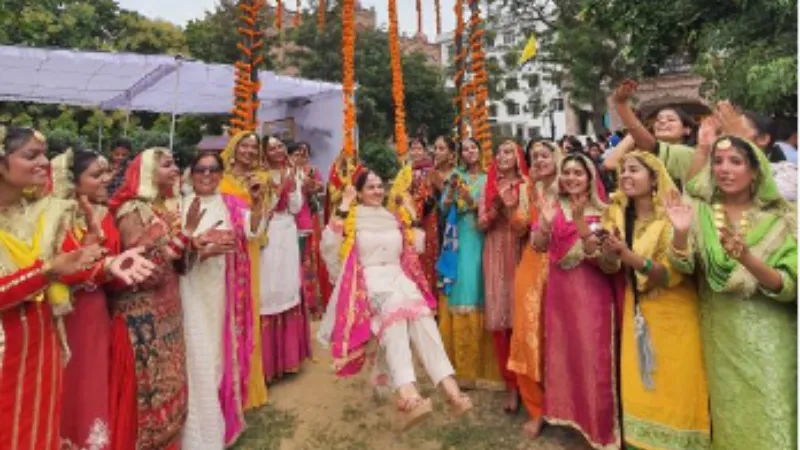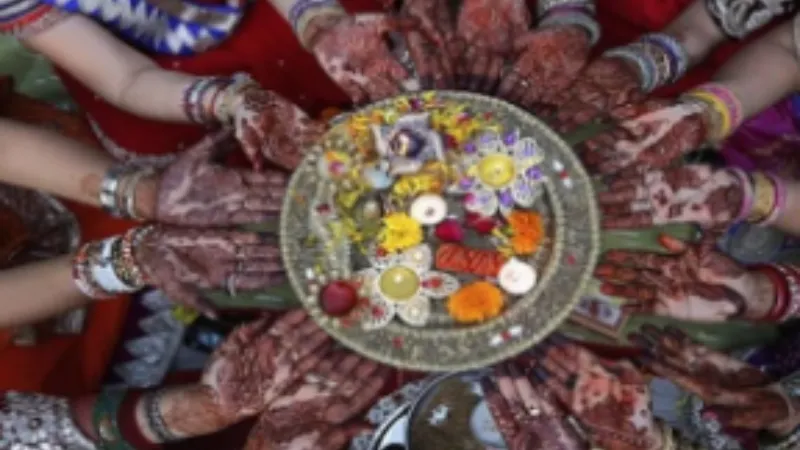
Teej (Sanskrit: तीज, romanized: Tīja), which literally translates as “the third,” refers to the third day following the new moon, when the monsoon commences according to the Hindu calendar. Teej is a collective name for three Hindu festivals, mainly honoring the Hindu deities Parvati, the mother goddess, and Shiva, her male consort. Married women and unmarried girls celebrate these festivals primarily in North India and Nepal, where they sing, swing dance, enjoy themselves, perform prayer rituals, dance, sing, and fast.
Read Also – 30 Best Summertime Destinations in India
“Teej” is a colloquial term for the three different Teej festivals: Hartalika Teej 15 days later, Kajari Teej 15 days later, and Haryali Teej on the third day following the new moon of the Shravana month. Known by various names such as Sindhara Teej, Chhoti Teej, Shravana Teej, Sawan Teej, or Haryali Teej (literally, “green teej”), it is observed on the third day following the new moon of the shravana month.
Married women visit their parents’ homes to celebrate by setting up swings on which they swing and sing happy teej songs. During the dark (waxing crescent) phase of the moon, 15 days following the “Haryali Teej,” people celebrate the Kajari Teej, also called the Badi Teej (literally, the “dark teej”).
One lunar month after the “Haryali Teej,” on the third day after new moon in the month of Bhadrapada, which typically falls a day before Ganesh Chaturthi, is the Hartalika Teej (literally, a composite word of “Harat” and “Aalika,” meaning “a woman’s kidnap with her consent by her female friends”). It commemorates the occasion when Parvati encouraged her friends to kidnap her to escape the marriage with Shiva after her father Himalaya wanted to give her hand in marriage to him. Married ladies celebrate it by keeping a “nirjala vrata” (water-less fast) in observance of their husbands’ long lives.
Teej Meaning And Origin
The monsoon season is when the red velvet mite (Trombidium), often known as Teej, first appears.
Teej is the name given to the third day of each lunar month that comes after the full moon night and the new moon (amavasya). Kajari Teej and Hartalika Teej are in Bhadrapada, according to Kumar (1988).
The festivities include social gatherings, rituals, and customs to honor the natural world’s abundance, the coming of clouds and rain, greenery, and birds. Women’s holidays include of eating celebratory dishes, dancing, singing, playing under trees on swings on Haryali Teej, gathering with friends and sharing stories, dressing up with henna-colored hands and feet, and clothing in red, green, or orange. In Rajasthan, the monsoon celebration is devoted to Parvati.
Teej Haryali
The Hindu holiday of Haryali Teej, also known as Green Teej, falls on the third day following the new moon in the month of Shraavana/Sawan. Shraavana Teej is also known as Hariyali Teej since it occurs during the monsoon or rainy season, when the surrounding area turns green.
In remembrance of Shiva and Parvati’s reunion and the day Shiva wed Parvati, the Hariyali Teej festival is also observed. In her 108th birth, Parvati was accepted as Shiva’s wife after she fasted and lived an austere life for many years. Parvati goes as Teej mata (literally, Teej mother).
Sindhara

Married daughters of Teej receive gifts from their mother, including garments, bangles, mehandi, bindi, and other items. On this day, they are offered ghevar, a particular treat. Sindhara is the name given to these gifts. Sindhara is said to have originated from the Sanskrit term sringar, which means “decoration of women and their charming beauty” (Bhatnager, 1988).
Keeping The Haryali Teej Holiday
The states of Punjab, Haryana, and Rajasthan commemorate Haryali Teej. Chandigarh also celebrates the festival.
Teej Kajari

On the third day of the dark fortnight of Bhadrapada, in the Bikrami lunar month, people celebrate Kajari Teej. Boorhi Teej is another name for Kajari Teej.[more citation(s) required] Following Haryali Teej, which is referred to as Chhoti Teej (lit. Smaller Teej), Kajari Teej is named Badi Teej (lit. Bigger Teej) in Rajasthan[extra citation(s) needed].
On Kajari Teej, women in Uttar Pradesh offer prayers to Shiva.[More citation(s) required] Singing the traditional songs known as kajris is also customary. The lyrics typically center on the theme of separation, portraying a woman’s longing for her partner when she is away from home celebrating Teej[more citation(s) required] or while she is waiting to be picked up by her brothers to celebrate Teej.[Reference required] The folk ballad “kajri” is performed and composed in the eastern states of Uttar Pradesh, Bihar, Madhya Pradesh, and Rajasthan.
Read Also – Almond Benefits For Women: Can Almonds Help Reduce Diabetes And Blood Sugar?
Ladies who follow the Kajari Teej fast abstain from food and liquids. Kajali Teej, which also involves prayer to the moon, is closely linked to Kajari Teej. Eating sattu breaks the fast.[Source self-published?] The neem tree is the object of prayer for the remainder of the day. In Bundi, Rajasthan, there is a fair called Kajali Teej Mela to commemorate Kajari Teej.[Needs a page][More citation(s) required]
Teej Hartalika

The Sanskrit terms harit and aalika, which translate to “abduction” and “female friend,” respectively, are combined to form the word hartalika. The tale of Hartalika Teej states that Parvati took on the form of Shailaputri.
Parvati constructed a Shiva lingam out of Ganga sand and silt on the third day of Bhadrapada’s bright half and offered prayers. Shiva promised to wed Parvati since he was so impressed. In the end, Parvati found her way to Shiva and, with her father’s approval, they were married. Since then, the day has been called Hartalika Teej because Parvati’s female friend (aalika) had to kidnap her (harit) in order for the goddess to fulfill her desire to wed Shiva.[Reference required]
Consequently, the third day of the bright half of the Indian/North Nepali lunar month of Bhadrapada is designated as Hartalika Teej, a prominent celebration. The festival women spend the evening of Hartalika Teej indulging in food, offering prayers to Parvati and Shiva, commemorating their marriage, and spending the entire night in prayer.[28][More citation(s) required] The fast, also known as the nishivasar nirjala vrat, begins in the evening of Hartalika Teej and is broken the following day following a full day of observation during which the women are not allowed to consume water.[Reference required] The goal is to offer prayers to Parvati .
Shiva wanted [page needed] to be the name of the person revered as Hartalika.[Reference required] Uttar Pradesh, Uttarakhand, and Rajasthan are the primary celebration regions. An idol of Parvati is paraded through the streets of Rajasthan while music and singing are played. Additionally, Hartalika Teej has extended to some areas of Chhattisgarh and Madhya Pradesh.[Reference required]
Maharashtra celebrates Hartalika teej, also called Hartalika tritiya vrat, in a manner akin to that of northern India. Married ladies observe it for their husbands’ well-being, longevity, and happiness in marriage, and single girls do it in appreciation of their good husbands. They fast for a full day and a half on this Nirjala Vrat. Women read katha, build idols of Shiva, Gauri, Sakhi, and Ganesha out of clay or river sand, maintain fasts, apply mehndi, and wear new red or green saris. They open vrat on the second day and perform bhajan sangeet puja at night as well. In India, ladies find great auspiciousness in worshiping goddess Parvati as Gauri and Shiva parivar.
About Latturam – latturam.com is a platform to know some facts about nature, history, health, environment and our lifestyle.
Read Also – 8 Tips To Make First School Day Easier For Kids



Comments